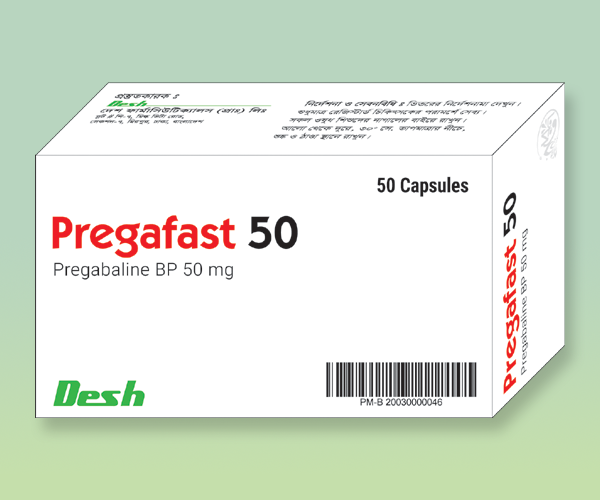Pregafast 50
Pregabaline BP 50mg
Pregafast 50
Pregabaline BP 50mg
PregaFast 50; Each Capsule Contains Pregabaline BP 50mg
- AVAILABILITY: AVAILABLE
Indications
Pregacap is indicated for:
- Neuropathic pain associated with diabetic peripheral neuropathy (DPN)
- Postherpetic neuralgia (PHN)
- Adjunctive therapy for the treatment of partial-onset seizures in patients 1 month of age and older
- Fibromyalgia
- Neuropathic pain associated with spinal cord injury
Pregacap CR tablet is indicated for:
- Neuropathic pain associated with diabetic peripheral neuropathy (DPN)
- Postherpetic neuralgia (PHN)
Pharmacology
Pregabalin is a structural derivative of the inhibitory neurotransmitter gamma-aminobutyric acid (GABA). It does not bind directly to GABAA, GABAB or benzodiazepine receptors. Pregabalin binds with high affinity to the alpha2-delta site (an auxiliary subunit of voltage-gated calcium channels) in central nervous system tissues. Although the mechanism of action of Pregabalin has not been fully elucidated, results in animal studies suggest that binding to the alpha2-delta subunit may be involved in Pregabalin's anti-nociceptive and antiseizure effects.
Dosage
Neuropathic pain associated with diabetic peripheral neuropathy in adults (DPN): The maximum recommended dose of Pregabalin is 100 mg three times a day (300 mg/day) in patients with creatinine clearance of at least 60 ml/min. Dosing should begin at 50 mg three times a day (150 mg/day). The dose may be increased to 300 mg/day within 1 week based on efficacy and tolerability. Begin dosing of Pregabalin CR capsule at 165 mg once daily and increase to 330 mg once daily within 1 week based on individual patient response and tolerability. The maximum recommended dose of Pregabalin CR capsule is 330 mg once daily.
Postherpetic neuralgia in adults (PHN): The recommended dose of Pregabalin is 75 to 150 mg two times a day or 50 to 100 mg three times a day (150 to 300 mg/day) in patients with creatinine clearance of at least 60 ml/min. Dosing should begin at 75 mg two times a day or 50 mg three times a day (150 mg/day). The dose may be increased to 300 mg/day within 1 week based on efficacy and tolerability. Patients who do not experience sufficient pain relief following 2 to 4 weeks of treatment with 300 mg/day and who are able to tolerate Pregabalin, may be treated with up to 300 mg two times a day or 200 mg three times a day (600 mg/day).
Begin dosing of Pregabalin CR capsule at 165 mg once daily and increase to 330 mg once daily within 1 week based on individual patient response and tolerability. Patients who do not experience sufficient pain relief following 2 to 4 weeks of treatment with 330 mg once daily and who are able to tolerate Pregabalin CR capsule, may be treated with up to 660 mg once daily. In view of the dose-dependent adverse reactions and the higher rate of treatment discontinuation due to adverse reactions, dosing above 330 mg/day should be reserved only for those patients who have on-going pain and are tolerating 330 mg daily. The maximum recommended dose of Pregabalin CR capsule is 660 mg once daily.
Management of fibromyalgia in adults: The recommended dose of Pregabalin is 300 to 450 mg/day. Dosing should begin at 75 mg two times a day (150 mg/day). The dose may be increased to 150 mg two times a day (300 mg/day) within 1 week based on efficacy and tolerability. Patients who do not experience sufficient benefit with 300 mg/day may be further increased to 225 mg two times a day (450 mg/day).
Neuropathic pain associated with spinal cord injury in adults: The recommended dose range of Pregabalin is 150 to 600 mg/day. The recommended starting dose is 75 mg two times a day (150 mg/day). The dose may be increased to 150 mg two times a day (300 mg/day) within 1 week based on efficacy and tolerability. Patients who do not experience sufficient pain relief after 2 to 3 weeks of treatment with 150 mg two times a day and who tolerate Pregabalin may be treated with up to 300 mg two times a day.
Conversion from Pregabalin capsules to Pregabalin CR capsule tablet: When switching from Pregabalin capsules to Pregabalin CR capsule tablet on the day of the switch, instruct patients to take their morning dose of Pregabalin capsule as prescribed and initiate Pregabalin CR capsule therapy after an evening meal.
Pregabalin tablet total daily dose (dosed 2 or 3 times daily): Pregabalin CR capsule dose (dosed once a day) - 75 mg/daily: 82.5 mg/day
- 150 mg/daily: 165 mg/day
- 225 mg/daily: 247.5 mg/day
- 300 mg/daily: 330 mg/day
- 450 mg/daily: 495 mg/day
- 600 mg/daily: 660 mg/day
-
Administration
Route of administration: Pregabalin is taken in oral route. It can be taken with or without food. Pregabalin CR tablet should be administered after an evening meal. It should be swallowed whole and should not be split, crushed or chewed. If patients miss taking their dose of Pregabalin CR after an evening meal, then they should take their usual dose of Pregabalin CR prior to bedtime following a snack. If they miss taking the dose of Pregabalin CR prior to bedtime, then they should take their usual dose of Pregabalin CR following a morning meal. If they miss taking the dose of Pregabalin CR following the morning meal, then they should take their usual dose of Pregabalin CR at the usual time that evening following an evening meal. When discontinuing both Pregabalin and Pregabalin CR, it should be gradually tapered over a minimum of 1 week.
-
Interaction
Drug interaction with medication: Pregacap is unlikely to be involved in significant pharmacokinetic drug interactions.
Drug interaction with food and others: Not applicable.Contraindications
Pregabalin is contraindicated in patients with known hypersensitivity to Pregabalin or any of its components.
Side Effects
Most common side effects in adults are dizziness, somnolence, dry mouth, edema, blurred vision, weight gain and thinking abnormal (primarily difficulty with concentration/attention). Most common side effects in pediatric patients for the treatment of partial onset seizures are increased weight and increased appetite.
Pregnancy & Lactation
There are no adequate and well-controlled studies with pregabalin in pregnant women. Pregnant women should be advised of the potential risk to a fetus. Small amounts of pregabalin have been detected in the milk of lactating women. Because of the potential risk of tumorigenicity, breastfeeding is not recommended during treatment with pregabalin.
Precautions & Warnings
Angioedema (e.g., swelling of the throat, head and neck) can occur and may be associated with life threatening respiratory compromise requiring emergency treatment. Pregacap should be discontinued immediately in these cases. Pregacap should also be discontinued immediately if hypersensitivity reactions (e.g., hives, dyspnea and wheezing) occur. Antiepileptic drugs, including Pregacap, increase the risk of suicidal thoughts or behavior. Respiratory depression may occur with Pregacap when used with concomitant CNS depressants or in the setting of underlying respiratory impairment. Patients need to be monitored and dosage adjusted as appropriate. Pregacap may cause dizziness and somnolence and impair patients ability to drive or operate machinery. Increased seizure frequency or other adverse reactions may occur if Pregacap is rapidly discontinued. Pregacap should be withdrawn gradually over a minimum of 1 week. Pregacap may cause peripheral edema. Caution should be exercised when coadministering Pregacap and thiazolidinedione antidiabetic agents.
Use in Special Populations
Use in children and adolescents: Safety and effectiveness in pediatric patients have not been established for the management of neuropathic pain associated with diabetic peripheral neuropathy, postherpetic neuralgia, neuropathic pain associated with spinal cord injury and fibromyalgia. In case of adjunctive therapy for partial onset seizures, safety and effectiveness in pediatric patients below the age of 1 month have not been established. The safety and effectiveness of Pregacap extended-release tablet in pediatric patients have not been established.
Overdose Effects
In case of overdose with Pregacap, sign and symptoms are reduced consciousness, depression/anxiety, confusional state, agitation and restlessness. Seizures and heart block have also been reported. There is no specific antidote. If indicated, elimination of unabsorbed drug may be attempted by emesis or gastric lavage; usual precautions should be observed to maintain the airway. General supportive care of the patient is indicated including monitoring of vital signs and observation of the clinical status of the patient.
Therapeutic Class
Adjunct anti-epileptic drugs, Primary anti-epileptic drugs
Storage Conditions
Keep in a cool & dry place (below 30°C), protected from light & moisture. Keep out of the reach of children.
